THE NATIONAL ART GALLERY
OF THE PHILIPPINES
As you enter the National Art Gallery, two imposing sculptures of National Artist Guillermo Tolentino greet you. They are heroic monuments, cast in metal, to Manuel Quezon, former Senate President, and Sergio Osmena, former Speaker of the House. At the lobby of the building are two wooden reliefs by National Artist Napoleon Abueva, assisted by Renato Rocha and Jose Mendoza. They portray Rajah Sulayman, His Court, and the Palisades (1967) and Legazpi and the Founding of Manila (1967). At the pediments of the back and front facades of the building and at the former Session Hall of the Philippine Senate are sculptures of Otto Fisher Credo, Walter Strauss, Vidal Tampinco, and Ramon Martinez.
|
Hall of Masters
This room is dedicated to the 19th-century Filipino painters Juan Luna and Felix Resurreccion Hidalgo who achieved prominence at the 1884 Madrid Exposition. Luna's Spoliarium received one of the three gold medals and Hidalgo's Virgenes Cristianas Expuestas al Populacho (Christian Virgins Presented to the Populace) received one of the fourteen silver medals.
|
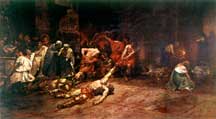 |
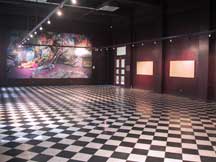 |
Holding Room
This is a multi-purpose hall where large groups are briefed before they are led through the rooms. Symposia, film viewing, concerts, and other events can also be held here.
|
|
Arellano Room
This room is dedicated to the prolific painter-architect Juan Arellano, who is one of the architects of this building. He was a pioneering modern artist and an exponent of Philippine neo-classical and art deco styles. He was also an urban planner, involved in the zoning of Manila and the design of Quezon City.
|
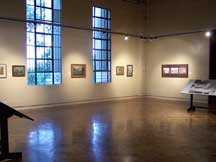 |
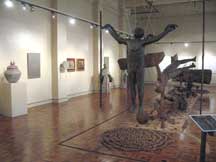 |
Beloved Land
The National Museum visual arts collection is organized according to phrases taken from the National Anthem.
This room introduces the scope of the history of art in the Philippines through a timeline. Together with this timeline are works that explain how the National Art Gallery is designed in terms of concepts and ideas. For instance, how it tries to reveal shifts and continuities in visual culture, or the culture of seeing and making reality visible in visual form.
|
|
Vessels of Faith
This room presents the various expressions of Philippine spirituality. The pieces here - from coffins to images for the altar - speak of belief systems and the ways by which their believers stage rituals, think about the afterlife, invoke the spirits, and so on.
|
 |
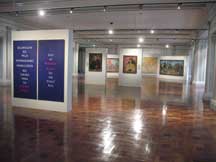 |
Hall of National Artists for the Visual Arts
This room is dedicated to the visual artists who have been named National Artists by the government.
|
|
Freedom Yearned For
This room expresses the theme of struggle of Filipinos against colonialism and the forms of oppression that persist to this day. It is about heroes and heroism, sacrifice and violence, atrocity and the spirit to claim liberty and independence.
|
 |
|
|









